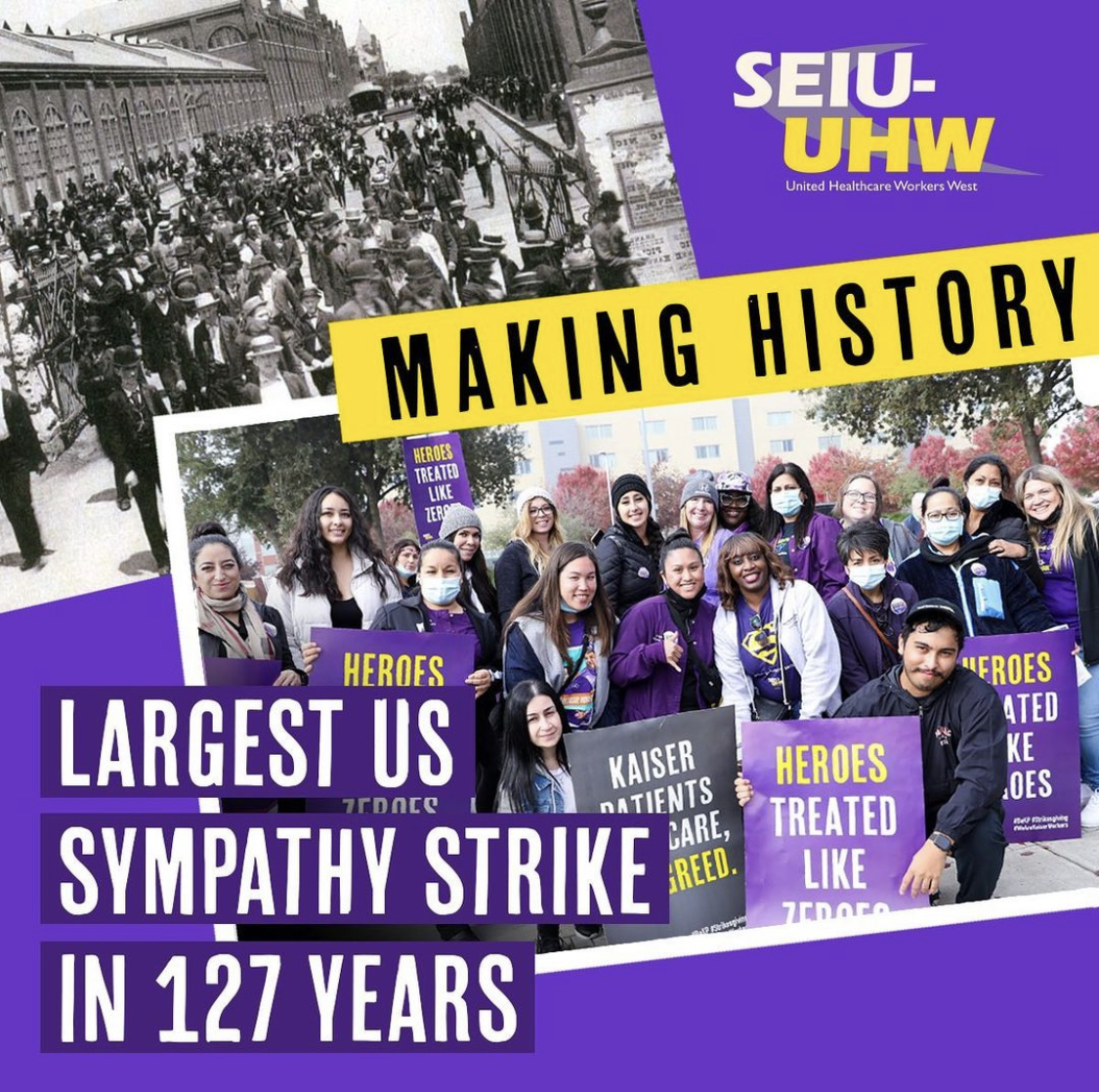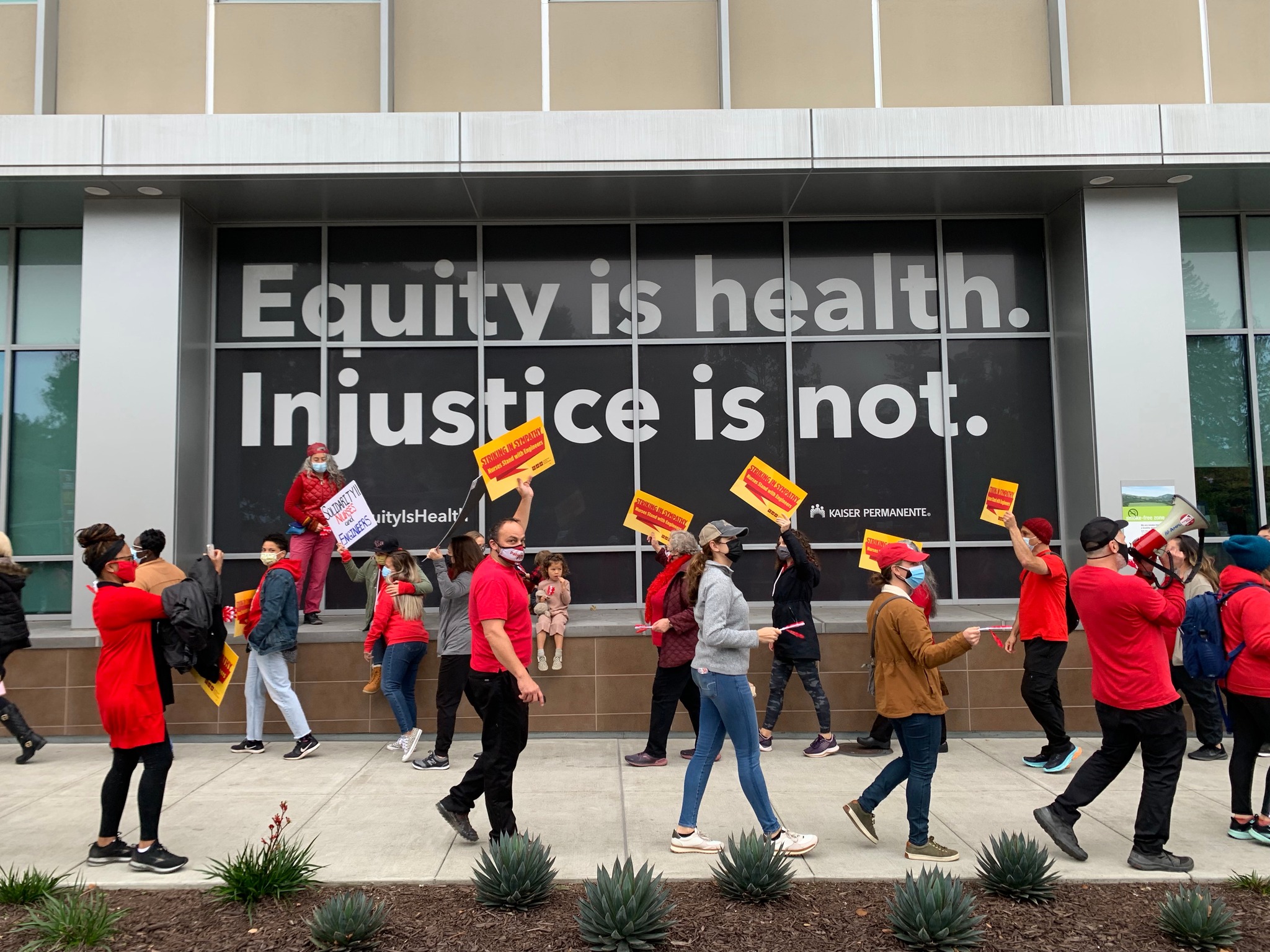Reviving the sympathy strike
Kaiser workers fight back

Two massive sympathy strikes took place in Northern California last week. Sympathy strikes—when workers strike in support of others involved in a labor dispute—are not common in the U.S. labor movement due in part to Taft-Hartley and other restrictive laws. As labor expert Kate Bronfenbrenner noted earlier this month, the recent sympathy strikes are a big deal: “It’s very revealing that all these workers—20,000; 30,000, however many it is—are willing to go on strike in solidarity with other workers. In the rest of the world, this happens all the time, but that is not something that happens in the U.S.” SEIU-UHW even announced that their strike was the “largest sympathy strike in 127 years” since the 1894 Pullman strike in Chicago, when a walkout snowballed into a two-month-long nationwide ”sympathy strike” that galvanized over 250,000 workers in one of the largest-ever organized work stoppages in U.S. history. Sympathy strikes need to be revitalized within the current labor movement, which is experiencing a strike wave, and laws broken in order to further build true solidarity amongst rank and file workers across unions.

Recent labor unrest at Kaiser
Workers at Kaiser Permanente have been flexing their own union power recently. Their issues are similar to what other workers have been experiencing across the country. From Nabisco and Kellogg to John Deere to healthcare, bosses are using workers’ “essential” labor to make astronomical profits, while demanding workers take cuts. During the COVID-19 pandemic, Kaiser has made $13 billion in profits. However, rather than spend that money on fair contracts and increased staffing, Kaiser is failing to invest in the very workers who keep their facilities running and their patients safe.
On November 13, Kaiser reached an agreement with the Alliance of Health Care Unions, averting a strike of over 50,000 employees in what would have been the largest work stoppage this year. After six months of bargaining and no agreement, three unions gave notice for an open-ended strike beginning November 15. Notably, this included 28,400 workers in Southern California who represent about 37 percent of Kaiser’s workforce in the region.
During contract negotiations with the Alliance, Kaiser offered one percent annual wage increases, a new two-tier wage structure that would permanently lower wage scales for all new employees hired after January 1, 2023, and no language around safe staffing. The Alliance pushed for four percent annual wage increases, no two-tier, and measures to ensure safe staffing. The tentative agreement, which still needs to be voted on by members, includes three percent wage increases in 2021 and 2022 followed by two percent and a two percent bonus in 2023 and 2024. The two-tier proposal was defeated. Kaiser will be required to share crucial information to make staffing decisions.
After five months of bargaining, the Guild for Professional Pharmacists, which represents about 2500 pharmacists in Northern California, gave notice for a weeklong strike starting November 15. At 1 am that morning, a tentative agreement for a new 3-year contract was reached. There is power in a strike notice. The Alliance and the pharmacists threatened strikes and got agreements.
Local 39 Engineers’ strike
Then there are the Local 39 Operating Engineers who have been on strike since September 18. Despite multiple bargaining meetings, Local 39 remains without a contract, and its roughly 700 workers in Northern California remain on the picket lines 68 days later.
The key bargaining issues have been wage increases to match comparable employers in the region and safe staffing. Kaiser has offered a one percent annual wage increase. They have also proposed to float engineers between facilities. This model would institutionalize the staffing shortages that have already hurt patients and workers. Healthcare workers know the devastating impact that short-staffing has had on the patient’s health and well-being throughout the pandemic.
Striking in sympathy

In a show of solidarity, other Kaiser unions went out for 24-hour sympathy strikes. The 40,000 members in SEIU-UHW, OPEIU Local 29, and IFPTE Local 20 held their strike on November 18. The strike effectively left Kaiser hospitals without patient care technicians, housekeeping, respiratory therapists, unit assistants, lab technicians, and more for the day.
The Northern California nurses represented by CNA and mental health workers represented by NUHW did the same the next day. The vibrant picket lines across Northern California Kaiser hospitals attracted media attention. Hundreds marched through the streets from Kaiser Oakland hospital to Kaiser headquarters in downtown Oakland.
Profiting through a pandemic
Kaiser has money—a whole lot of it. In 2020, the company reported a net income of $6.4 billion, an incredible sum despite being down 19 percent from $7.4 billion in 2019. Additionally, it retains $44.5 billion in cash reserves. There is no question: Kaiser can afford to pay its workers fair wages.
Rather than come to a fair agreement with Local 39 engineers, Kaiser fortified itself for the 2 days of sympathy strikes, saying it would “spend significantly” to hire, train and relocate contract replacement workers. At the picket lines at Kaiser Oakland, four buses of travel nurses were brought in at 5 am on Friday. Despite this, staff nurses on the picket lines received desperate pleas to come into work.
With 12 million members, Kaiser has upped its PR game in an effort to preserve the company’s reputation. Northern California members received notices of reduced services during the sympathy strikes along with the reassurance that “We continue to bargain in good faith with our labor unions.”
But this isn’t true. On the day before the sympathy strikes began, Kaiser was said to spend only 20 minutes bargaining with the engineers, and their economic offer is still less than what they just agreed to with the Alliance days before. Kaiser has yet to meet with Local 39 since the sympathy strike.
Winning together
In the past, Local 39 has gone on sympathy strikes to support other unions during their contract negotiations. Now, those unions are striking in sympathy with the engineers. This type of solidarity is crucial. Local 39 is a small union local, with about 700 members spread out over multiple facilities. It has been challenging for them to attract the media attention that helps generate community support. The two days of sympathy strikes reinvigorated the picket lines and demonstrated that Kaiser workers and Kaiser members support the engineers. Furthermore, the collective union work stoppage significantly impacted Kaiser operations.
Dan, who has been an engineer at Kaiser for over 21 years and is on strike for the first time, told Tempest, “The sympathy strike support has significantly impacted the hearts of all engineers and has helped to uplift our spirits during this difficult time. As the holidays approach, we ask Kaiser to step up and bargain in good faith by giving us a fair deal.”
Follow this rank and file initiated Instagram account for updates: @local39strikeagainstkaiser
Donate to Local 39 picket line strike funds:
Local 39 Strike Fund Oakland and Richmond Kaiser
Help “Local 39” Strikers WC-Antioch-Mtz Kaiser
Kaiser Fresno Strike
Vallejo Kaiser Stationary Engineers Fundraiser
Help Local 39 (Fremont Kaiser Engineers)
Featured Image Credit: Photo by Emma Wilde Botta, modified by Tempest.
Categories
We want to hear what you think. Contact us at editors@tempestmag.org. And if you've enjoyed what you've read, please consider donating to support our work:
DonateEmma Wilde Botta & Elizabeth Lalasz View All
Emma Wilde Botta is a nurse and member of California Nurses Association. Elizabeth Lalasz is a steward in Chicago with National Nurses United and on the steering committee of the Chicago DSA Labor Branch.
